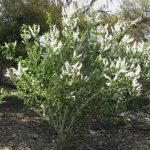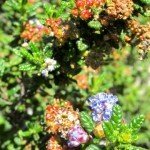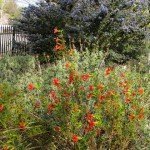I realize I haven’t written about ceanothus – commonly called wild lilac, which has been ablaze with its blue blooms lately. So here is another favorite, which has done really well on the two properties where we planted it. It’s short-livedness is a rumor for us, and backed up by ceanothus in the wild living 90 to 100 years. Here are some factoids and photos.
Plant Characteristics
(from my docent classes at the San Diego Museum of Natural History)
- 43 of the 50+ species worldwide are in California, a dozen of those located in chaparral. See below for example of one growing in the Midwest/east
- Many varieties exist, ranging from low groundcover types – such as our Blue Sapphire ceannothus (see photo to right) up to specimens 15 to 20 feet tall. See Las Pilitas website for great descriptions of CA ones.

Low-growing Sapphire blue has deep blue flowers and deep green foliage - Their hefty leaves have three distance veins and because the plant expends significant energy to make them, they last a long time. Ceanothus has a deep taproot.
- Flower color: white to dark blue.
- They’re fast-growing because they’re a nitrogen-fixing plant (see photo below)
- They need heat or smoke to stimulate germination so are called obligate seeders (also called fire dependent.) And – research shows their seeds can survive 100 years
- Water a lot when you plant and throughout the first year. But once it gets established, don’t overwater, especially in the summer in Southern California.
Habitat Value

Their berries and seeds are important food for animals. Deer, quail, even porcupine browse, hummingbirds and bees depend on the flowers. They also provide shelter for nests.
Favorites
We’ve had great luck with Ray Hartman, Dark Star, Concha and Julie Phelps – but really, if you pick one whose description fits your area’s climate, it should do well.
Midwest favorite: Susan Damon in Minnesota likes the Ceanothus americanus or New Jersey Tea, a small shrub 2-3′ with clusters of tiny white flowers. ” It attracts many small bees and other pollinators. I have read that hummingbirds visit the plant to eat insects but have never actually seen that in my garden,” Susan says. According to Trees and Shrubs of Minnesota by MN DNR botanist Welby Smith, “The common name dates from the Revolutionary War, when the leaves were supposedly used as a substitute for oriental tea. The taste is reportedly similar to oriental tea but it contains no caffeine.”








We have a variegated ceanothus with light blue flowers that we would like to transplant to another location. Do you know whether they have huge tap roots?
I believe they do – many native plant shrubs do send down deep roots which enable them to grow pretty quickly and survive drought. Now is the time to transplant them, tho. We have found transplanting doesn’t always work, because the plant to too large and those deep roots that get broken off. Also, we try to do it on cloudy days so the stress is less, and water them well at planting time. Good luck!
Very good information i bought 10 of this plants today, i am going to plant them close to a retainer in front my house only have 12 to 15 ” from the wall ,I was wondering about they roots systems since they can grow up 8 ‘ also mix them with roses
be careful with the roses, which need water year-round. Ceanothus should not get a lot of water in the hot summer months because they can get root rot easily. It’s especially important to not water them directly in the heat of the day. Ours have all survived on at most once/monthly water in the summer once they’re established, and we did any watering on an overcast, cooler day. The roots tend to go deep downward so a couple feet from your wall should be good
I have ceanothus that I allow to grow as much as it wants in the fall and spring so I get maximum bloom capability for bees hoverflies and all manner of insect life. However, since it is in an enclosed back garden the berries will not feed the animals and birds you mention. Do I prune back as I usually do and lose the berries? Will it feed any other bird than quail. I’ve never seen birds on the bush, perhaps I am missing them….feeding that is.. Please advise and thanks so much.
Hansa, you will get birds coming in I’m sure – besides quail there are finches (goldfinches, house finch….) and bushtits that feed on the seeds so I wouldn’t worry about it not providing good habitat value. I would however, not prune before the flowers become berries. When the berries dry is when we’ve seen most birds on the bushes. Besides, the best time for pruning ceanothus (and most native plants) is late fall/early winter after they enter dormancy and before new growth appears. But there are other insect-eating birds that come feed on the insects the flowers and sticky berries attract
Is there a good method to use for pruning ceanothus?
Hi Merrilee, here’s info on pruning ceanothus that I have in my pruning native plant article on this website – Ceanothus: Pinch and lightly prune in spring after flowering and when they